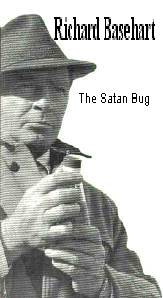|
|
|
|
| What follows was compiled from a series of interviews
conducted early this year. The FILMFAX article had not directly addressed
how he had come to work in the film industry in the first place, so we got
into that, and the story unfolded from there.
"Well, you asked for it. I was discharged from the Navy in 1952 and went to live in New York City. My place of birth is Connecticut. During the time I lived in New York City, I decided that I wanted to become an actor, took classes, starved, auditioned, worked temp jobs and all of the usual things a starving actor does. I couldn't get arrested or cut the mustard, so I gave up the idea and started modeling. That too was short lived, since just at that point in time pretty boy types like me were on the way out, and models with craggy faces and lots of character were in. |
|
| "Shortly after that, I rented an apartment in Hollywood, and across the hall from my apartment lived a single mother of three. She worked at anything that would allow her to raise and feed her children. I sometimes babysat for her after she landed a spot as the weather girl on a local TV channel. Over coffee one day, she said, why don't you become an extra in the business? She knew that I was extremely unhappy with my job as a mercantile credit salesman with Dunn & Bradstreet. |
 |
"I didn't know what to think. I'd seen her phoning in daily for work and saw how much rejection was involved, which I didn't think I could handle. Also, I was 31 years old, and in those days it was legal to discriminate against age; Central Casting was not accepting anyone over 25. But she eventually pulled some strings with friends, and I lied a bit about my age (I could pass for 25 at the time, and with all humility, I don't look 71 today). Anyway, I was accepted, but I did very poorly those first few months because it's important to be known, which I wasn't. Central Casting had their favorites. Assistant directors usually requested extras that they knew they could depend on, extras being held in very low esteem. I noticed that the stand-ins worked steady, had the ear of the assistant director and could be helpful to new extras. I got a few jobs through that route, and one was as an extra here in Palm Springs on a Richard Basehart movie called The Satan Bug which was filmed in early spring, 1964. I was more or less offered a brass ring, caught it and held on tightly. The rest is history." |
| Didsbury's work as an extra on The Satan Bug was originally to have lasted just three days. This was extended when the assistant director [AD] asked if he would stay on as Richard Basehart's stand-in. "Extras did not like to stand in. When an AD would ask extras to do so, most would do it for perhaps one set up and then disappear, or they'd intentionally do a bad job, all to ensure never being called on again. When asked to do it just for that day, I jumped in with both feet." As a result, Didsbury was asked to stay for the rest of the indoor shoot at Goldwyn Studios long after the other extras had been sent back to L.A. It was during this filming that he became friendly with Basehart, and that friendship would soon unlock the door to steady employment on Voyage. |
|
|
From the start, Didsbury took his work seriously, and was always willing to tackle anything new that came along. But it wasn't Voyage producer Irwin Allen who initially expanded Didsbury's role in the ongoing production. "Irwin's only interest in me was my voice and as a liaison to Richard [Basehart]. He did not give me the added responsibility--it came from Joe DeAgosta who was in casting at the time, and from the on-set assistant directors. A.D. Jack Stubbs allowed me lots of leeway as far as "gaffing" the background extras as well as positioning myself in the scenes." It was Irwin
Allen's interest in Didsbury's voice that led to his
earning additional exposure and income from Voyage doing
voice-overs. "We had a female
script supervisor and Irwin could not stand hearing her voice in dailies
even though she was a relative. He did not like her voice and told
the assistant director to do it. The AD did not want to be bothered,
plus when a scene is being shot he has other things to be responsible
for. I got tapped by Jack Stubbs, our AD, and the powers liked what
they heard in dailies. Later, along came the job of Dialogue Coach,
and once again it was mine." |